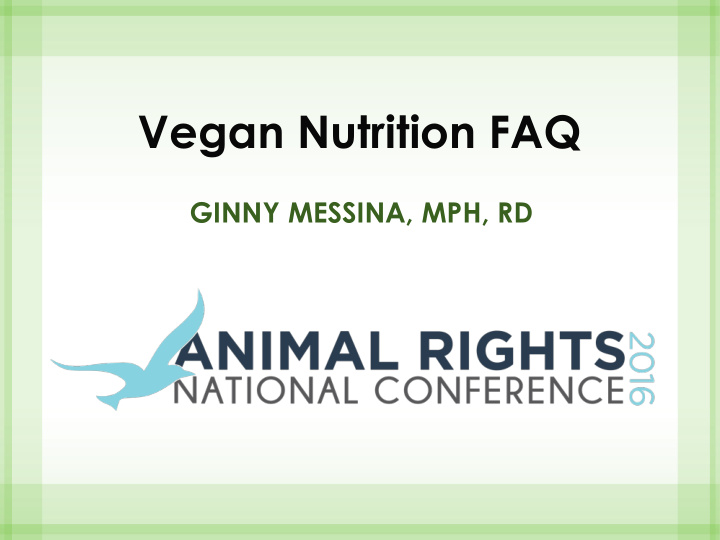



Vegan Nutrition FAQ GINNY MESSINA, MPH, RD
How can vegans protect bone health? How can vegans ensure good absorption of iron and zinc? How much soy is safe to eat? Should vegans eat a low fat diet? Junk food vegans: Is there really such a thing?
Eating for Strong Bones Calcium Protein Fruits & Vegetables Vitamin D
Hip Fracture Rates & Animal Protein Intake Hip fracture rate/100,000 Animal protein intake (grams/day)
Hip Fracture Data Ecological Study • Studies that pool data from different groups and compare the averages — rather than comparing information from individuals • Don’t control for other variables • Miss important factors that might affect the comparisons
Genetic Differences Asians have a shorter hip axis length which protects against fractures
Cultural Strength Differences Balance
Even where hip fracture rates are low, osteoporosis is common
Comparison of fracture rates among people in Japan, Hong Kong and Sweden Japan and Hong Kong: Lower risk of hip fracture Higher risk of spinal fracture
Hip fractures: Due to falling Spinal fractures: Due to osteoporosis
Adventist Health Study
Protein protects bone health • Improves calcium absorption • Contributes to bone structure • Promotes muscle strength
Get Adequate Calcium
Vegans often have lower calcium intakes than omnivores and lacto-ovo vegetarians
EPIC-Oxford 2007 Findings Vegans were 37% more likely to fracture a bone than meat- eaters and lacto- ovo vegetarians
Calcium Intake (mg/d) in the EPIC-Oxford Group Calcium Omnivores 1,057 Pesco- 1,081 vegetarian Lacto-ovo 1,087 Vegan 610 Public Health Nutrition: 6(3), 259 – 268
Calcium without cows Wild greens supplied abundant calcium to early humans
All vegan food groups provide calcium
All vegan food groups provide calcium
All vegan food groups provide calcium
Best Plant Sources of Calcium Fruits Figs Fortified juices Legumes Tofu Soybeans Nuts/Seeds Almonds Almond butter Tahini Milks Vegetables Any fortified plant milk Leafy greens
Calcium from Leafy Greens Good sources: Bok choy, collards, kale, turnip greens Poor sources: Spinach, Swiss chard, beet greens
Ensuring Adequate Absorption of Iron and Zinc
Best Vegan Sources of Iron: legumes, nuts, whole and enriched grains, soyfoods, spinach, Swiss chard, dried fruits
Dietary Iron Content mg of iron Food Salmon, 3 oz 0.6 Chicken, ½ breast 0.6 Beef, 3 oz 1.3 Soymilk, 1 C 1.6 Black-eyed peas, ½ C 2.2 Tofu, 3 oz 3.0 Lentils, ½ C cooked 3.3
Dietary Iron Content mg of iron Food Salmon, 3 oz 0.6 Chicken, ½ breast 0.6 Beef, 3 oz 1.3 Soymilk, 1 C 1.6 Black-eyed peas, ½ C 2.2 Tofu, 3 oz 3.0 Lentils, ½ C cooked 3.3
Phytate Iron Iron
VITAMIN C • Citrus fruits • Strawberries • Green leafy vegetables • Peppers • Cauliflower • Cabbage
Iron + Vitamin C Oatmeal with strawberries Grains and beans with leafy greens
Vegans and Zinc Phytate binds zinc Vegans sometimes have lower intakes
Best Vegan Sources of Zinc: Legumes, nuts, seeds, whole grains, soyfoods
Improving Zinc Absorption Protein Leavening Fermenting Sprouting
How Much Soy is Safe to Eat?
Soyfoods are uniquely-rich sources of isoflavones ● Type of phytoestrogen (plant estrogen) ● Similar chemical structure to estrogen ● Able to bind to estrogen receptors ● Exert some estrogen-like effects ● Different from the hormone estrogen
Clinical Effects of Isoflavones and Estrogen Isoflavones vs. Estrogen Estrogen Isoflavones Hot flashes Yes Yes Improve endothelial function Yes Yes Wrinkles Yes Yes Reduces bone loss Yes No Clotting Yes No Stimulates breast tissue Yes No
Soy and Breast Cancer • Clinical studies: No adverse effects on breast tissue • Early soy consumption reduces lifetime risk of breast cancer • Women with breast cancer who consume soyfoods have improved prognosis
Clinical studies show no effects of soy or isoflavones on: ● Blood testosterone levels (>36 studies) ● Blood estrogen levels (>9 studies) ● Sperm/semen parameters (3 studies)
How are Soyfoods Consumed in Asia? Condiment style?? Fermented vs. Non-fermented??
Asian Soyfood Consumption Location Servings Type of per day soyfood Shanghai 1 – 2 Non-fermented 50% Non- Japan 1 – 2 fermented 70% Non- Korea ½ – 1 fermented Singapore, ~½ Non-fermented Hong Kong
Adult Intake recommendations 1-3 servings/day ½ cup tofu, tempeh, edamame ¼ cup soynuts 1 cup soymilk
For young girls, one serving per day of soyfoods may be enough to lower lifetime risk for breast cancer
Should Vegans Eat a Low-Fat Diet?
Essential Omega-3 Fatty Acid: Alpha-linolenic acid (ALA) ● Walnuts (8 halves) ● Ground flaxseed (1 tbsp) ● Flaxseed oil (1 tsp) ● Hempseed oil (2 tsp) ● Walnut or Canola oil (1 tbsp) ● Soy oil (2 tbsp)
DHA and EPA • Long-chain omega-3 fats • Found in fatty fish • May reduce risk for heart disease, dementia, depression
Conversion is relatively poor Alpha-linolenic acid (essential omega-3 fatty acid) DHA and EPA (long chain omega-3 Vegans typically fats) have low blood and tissue levels of DHA and EPA
Fish Get DHA and EPA from Algae…We Can, Too
Vegan Omega-3 Fats from Algae 200-300 mg DHA + EPA 2-3 times per week
Healthy Sources of Fats • Nuts • Seeds • Avocado • Olives • Vegetable oils
Benefits of High-Fat Plant Foods • Nuts and seeds provide zinc • Nuts reduce risk for heart disease • Replacing saturated fat with plant fats improves cholesterol levels
Including Healthful Fats in Vegan Diets • Broadens culinary options • Makes it easier to plan appealing vegan meals • Makes it easier for people to go vegan, stay vegan, and stay healthy
“ Junk food vegans” versus “ healthy vegans?” A False Dichotomy
Junk Food Vegans?
Not all processed foods are “junk”
The Vegan Food Pyramid (According to non-vegans)
An Optimal Vegan Diet • Meets nutrient needs • Reduces risk for chronic disease • Practical, easy, realistic • Appealing
Familiar Flavor and Texture
Add creamy texture with blended cashews, vegan sour cream, avocado
Add meaty texture with veggie meats, frozen defrosted tofu, seitan
Convenience
Emphasize Whole Plant Foods Make Room for Healthy Processed Foods, Convenience, Flavors & Textures Treats
TheVeganRD.com @TheVeganRD ginnymessina@gmail.com
Recommend
More recommend